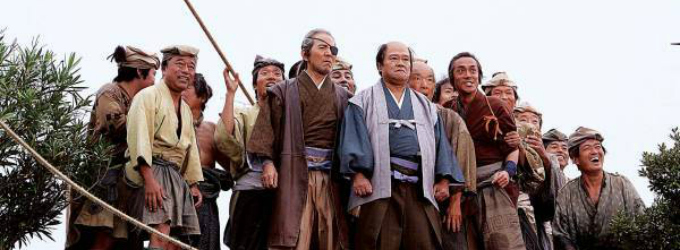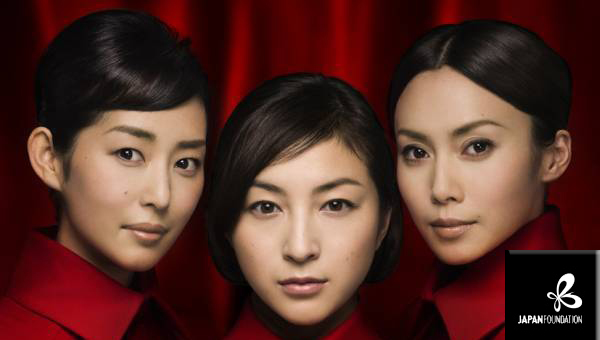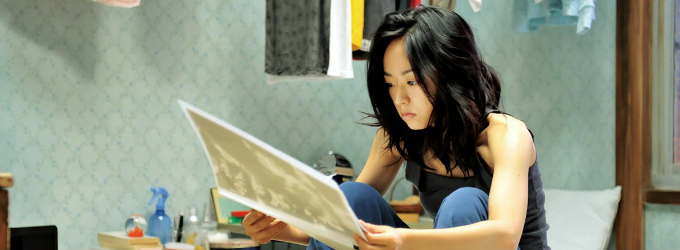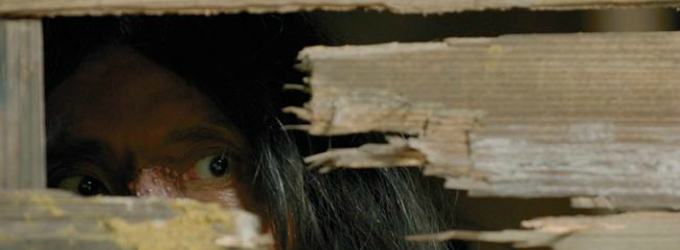 If you were to try to sum up the nature of the Japanese and their complex relationship with the past, there could be no more apt description than the famous quote about the past being a foreign country where they do things differently. The Japan Foundation’s 2013 Touring Film Programme sheds some light on those dark foreign places, in their 10th season: ‘Once Upon A Time in Japan: Reinventing the Past Through the Eyes of Japanese Contemporary Filmmakers‘. It’s a vast subject, but the ten films selected for the programme approach the subject directly and indirectly through a wide range of styles. From horror, comedy, thrillers and animation, to period films and docudramas, the season demonstrates the richness, the diversity and the relevance of a contemporary Japanese cinema that is vastly under-represented on the international film circuit.
If you were to try to sum up the nature of the Japanese and their complex relationship with the past, there could be no more apt description than the famous quote about the past being a foreign country where they do things differently. The Japan Foundation’s 2013 Touring Film Programme sheds some light on those dark foreign places, in their 10th season: ‘Once Upon A Time in Japan: Reinventing the Past Through the Eyes of Japanese Contemporary Filmmakers‘. It’s a vast subject, but the ten films selected for the programme approach the subject directly and indirectly through a wide range of styles. From horror, comedy, thrillers and animation, to period films and docudramas, the season demonstrates the richness, the diversity and the relevance of a contemporary Japanese cinema that is vastly under-represented on the international film circuit.
There aren’t many contemporary Japanese films that deal directly with the events of the War in the Pacific and its abrupt end that came about with the destruction of Hiroshima and Nagasaki. When it is taken on directly in a film like Junya Sato’s YAMATO (2005), a film about the legendary battleship destroyed at Okinawa, there’s something deeply uncomfortable about an old-fashioned war movie that takes the Japanese perspective of nationalistic pride at brave sailors setting out to be massacred in the Pacific. By contrast, the indirect approach of genre movies can be much more revealing about the impact of the war on the Japanese psyche, in the apocalyptic monster movies and SF anime series of super-powered teenagers, and in literary thrillers by writers like Seicho Matsumoto (Inspector Imanishi Investigates).
…the past has left its mark indelibly on the character of a nation trying to find its feet in the post-war world…
The war isn’t far beneath the surface in Isshin Inudo’s ZERO FOCUS (2009), a Hitchcockian thriller based on a Matsumoto novel. A recently married young woman travels to Kanazawa in the frozen north of the country, in search of her husband Kenichi who has gone missing while on a work assignment. Set at the end of the post-war years in 1957, the investigation highlights the new progressive society in Japan, with aggressive business interests rebuilding the economy and a woman attempting to be elected mayor. But it also shows that the past has left an indelible mark on the character of a nation trying to find its feet in the post-war world. The thriller elements and increasing body-count come to dominate proceedings, and topple the film over the edge of plausibility somewhat, but there are some interesting details relating to American interests in Japan in the post-war years and their enduring legacy. Much more successful at viewing the traditions of the past with the sensibility of the present, Kazuo Kuroki’s THE BLOSSOMING OF ETSUKO KAMIYA (2006) takes a more poetic and reflective approach to the war. A simple Ozu-like family drama based around a marriage proposal, Kuroki’s film manages to place the events of Spring 1945 into a more meaningful human context.

The present economic crisis certainly seems to have had as profound an impact on the Japanese psyche as the War. On the one hand, the Jidai-geki period dramas of Yoji Yamamoto’s TWILIGHT SAMURAI (2003) and THE HIDDEN BLADE (2004), along with Yojiro Takita’s WHEN THE LAST SWORD IS DRAWN (2003) offered a rather conservative response to the sense of discontent at the breakdown of traditional family and social values, causing them to look back with rose-tinted glasses (and sepia-toned cinematography) at a romanticised and revisionist ideal of the past. Even though times may have been tough at the bottom of the ladder in feudal Japan, the period drama offered the comforting lie of social cohesion, in the sense that at least you knew where you stood back in those days. Even if you were a lowly serf, if you worked hard, honestly and loyally, you could still find some measure of happiness and fulfilment with your lot.
Mitsutoshi Tanaka’s CASTLE UNDER FIERY SKIES (2009) doesn’t stray too far from this position. Set 500 years ago during the Civil War period, a master carpenter, Mataemon Okabe, demonstrates his sense of honour, hard work, obedience and self-sacrifice when asked to build a five-story castle out of the Azuchi mountain for Lord Oda of the Owari province. When the ability of the lowly craftsman is questioned, Mataemon demonstrates the superiority of his designs, and suggests going even further to make it seven floors high. The film has a mainstream made-for-TV sensibility, with no great artistic flair, and is laid out along conventional plot lines to present the idea that “building a castle is like building a nation”. A brief flying sword-fighting sequence that seemingly erupts out of nowhere feels a little out of place, but there is a Fitzcarraldo-like fascination in seeing how the villagers overcome the challenges of a foolhardy enterprise to build what ominously becomes known historically as the Phantom Castle.
A brief flying sword-fighting sequence that seemingly erupts out of nowhere feels a little out of place…
It’s no coincidence that subsequent years saw a surprising amount of time-travel films in Japanese cinema. As if it wasn’t enough merely to look back nostalgically at “simpler” times, it seemed as though the desire to escape from the current period of economic uncertainty and social upheaval of the present was so strong that one had to actually go back in time to restore a sense of order and pride in the nation. Some of these films, like Katsuyuki Matohiro’s SUMMER TIME MACHINE BLUES (2005) used the idea simply as an excuse for escapist Bill and Ted-like comic adventures, while others like Tetsuo Shinohara’s METRO NI NOTTE (2006) seemed to reveal a reactionary, almost pathological impulse not just to turn back the clock and seek refuge in an idealised version of the past, but to trace back to the roots of the malaise and actually alter significant events – even the outcome of the war – so that the crisis in the future might never happen.
Yasuo Baba’s 2007 timeline shifting comedy BUBBLE FICTION: BOOM OR BUST manages to indulge a bit of nostalgia while at the same time finding a very humorous way to point out where it all went wrong, when a nightclub hostess travels 17 years back in time (through a washing machine) to 1990 to try and avert the looming disaster that will plunge Japan into economic meltdown. While there is considerable fun to be had at the carefree spending of the 1990s, at the fashion and the thickness of women’s eyebrows, glammed-up discos, and mobile phones the size of bricks, BUBBLE FICTION: BOOM OR BUST’s funny conspiracy theory action drama makes it quite clear who is at fault for the current debt crisis, at the same time as it imagines how things might have been otherwise. And if you can help Japan win the 2002 World Cup while you’re at it, well, why not?
Time travel is involved in a rather different way in Sunao Katabuchi’s MAI MAI MIRACLE (2009). Seen by many outside Japan as cartoons for children, anyone who has any experience of the anime phenomenon can recognise its ambition and sophistication as an artform. Even though it is ostensibly a children’s film, MAI MAI MIRACLE manages to be one of the most layered films in how it relates to the Japan Foundation Touring Programme’s theme of “looking back at the past”. On the surface it vividly recreates a small community in the countryside in the 1950s, but inspired by her grandfather’s stories, 10 year-old Shinko is able to imaginatively recreate the society around a once-important mansion that existed on the site 1,000 years ago. Made by a former assistant to Hayao Miyazaki, the film is a beautiful evocation of childhood in its content and in its playful, fluid structure. Also related to the anime theme, although its evocation of the past is perhaps more related to nostalgia for a 1990s cartoon series than its actual 16th century setting, NINJA KIDS!!! (2011) is a live-action children’s comedy by none other than Takashi Miike, one of the most controversial and unpredictable figures in Japanese cinema. If it never quite lives up to the anarchic potential of its premise, the exaggerated CGI cartooniness of the film and its characters is an absolute delight and a welcome change of tone from the reflective musings elsewhere.
An entirely different side of Sang-il Lee can be seen in HULA GIRLS (2006), a heart-warming comedy that has been described as the “Japanese FULL MONTY“.
As an example of the Japanese horror genre, even the ghost-story anthology KAIDAN (2010) is not immune from the reflective approach that characterises most of the films here. Inspired by Lafcadio Hearn’s influential 19th century collection of folk-tales, the series takes a modern and realistic approach that gives a strong psychological underpinning to the three horror dramas. Filmmakers Shinya Tsukamoto, Sang-il Lee and Hirokazu Kore-eda take an unconventional approach which yields surprising results.
An entirely different side of Sang-il Lee can be seen in HULA GIRLS (2006), a heart-warming comedy that has been described as the “Japanese FULL MONTY“. The film certainly shares some common themes – a dance troupe is formed to escape the poverty and unemployment in a small coal-mining village – but it also capitalises on the feel-good phenomenon of Suo Masayuki’s SHALL WE DANCE? which was recently remade in the US. The idea of creating a Hawaiian Centre in a cold remote part of Japan, as a solution to the decline in the local economy, is so surreal that it could only come from a true-life story. But it’s the performances of the young cast that make it a truly invigorating and heart-warming experience. HULA GIRLS may not miss any opportunity to show eyes swelling with tears as the underdogs overcome adversity through their inspirational teacher, but Sang-il Lee orchestrates sequences well in the build-up to the big finale.
The remaining two films in this diverse season show very different individual and collective responses to the theme of Japan and its relationship with the past. Perhaps the most challenging film – “punishing” is another word you could use to describe it – is Koji Wakamatsu’s three and a half hour long UNITED RED ARMY (2007), a docudrama based on the formation of a radical revolutionary left-wing activist group that arose during the student protests in the 1960s. Using documentary footage and dramatic reconstructions based on interviews with Red Army members, with seemingly endless “self-critique” sessions that almost have the viewer breaking down and begging for mercy, Wakamatsu’s film makes the operations in Olivier Assayas‘ CARLOS look like a picnic. It shows a very dark and brutal side of human nature that is difficult to relate to, but it is an aspect that shouldn’t be overlooked in any examination of Japan’s past.
Some very dark places are also visited, and a very different form of self-criticism is also called for in Izuru Narushima’s REBIRTH (2011), a film that won in 11 categories at the 2012 Japanese Academy Awards, including Best Film and Best Director. Abducted as a child and having grown up believing her abductor was her mother, a young woman takes to the road to revisit her past in search of answers. Beautifully photographed with a meaningful structure and strong acting performances, REBIRTH never settles for any easy conventional resolutions. Through its personal drama, the film finds a unique way to explore the deeper implications of living with a troubled past, but it also suggests that the outlook might not necessarily be as bleak as it seems. Over a season of Japanese films that in one way or another have sought refuge in or an accommodation with the past, REBIRTH’s humanistic outlook suggests a somewhat radical way of breaking with the past, putting its faith in the freedom of the individual to choose their own destiny.
Reinventing the Past Through the Eyes of Japanese Contemporary Filmmakers
Marking its 10th anniversary, the Japan Foundation Touring Film Programme looks back into the past through the eyes of contemporary filmmakers. Touching upon a trend prevalent in recent Japanese cinema, this season showcases a series of works from directors including Takashi Miike, Sunao Katabuchi, Hirokazu Kore-eda and Isshin Inudo, who all share the same aspiration to reinterpret and relive moments of times gone by through a variety of genres, styles and tones. The programme began on 1 February 2013 and its nationwide tour runs until 27 March 2013.



